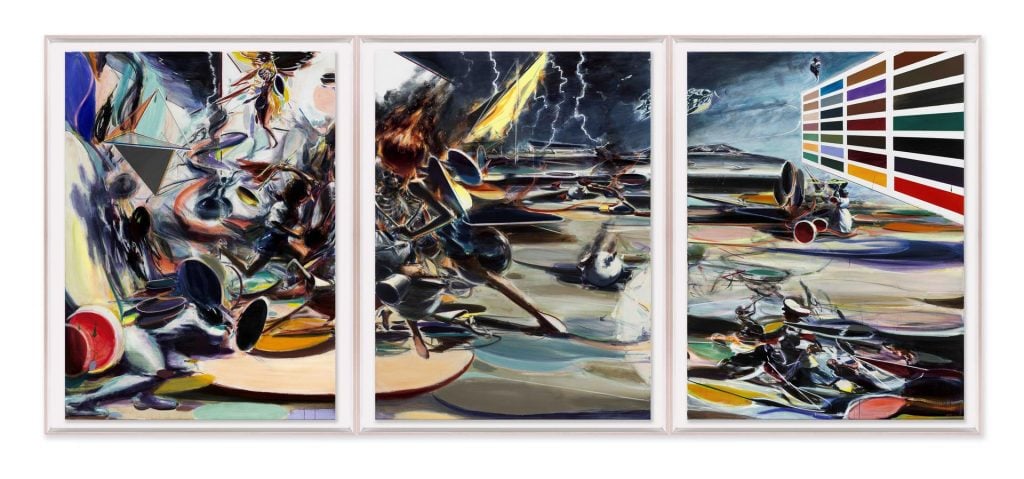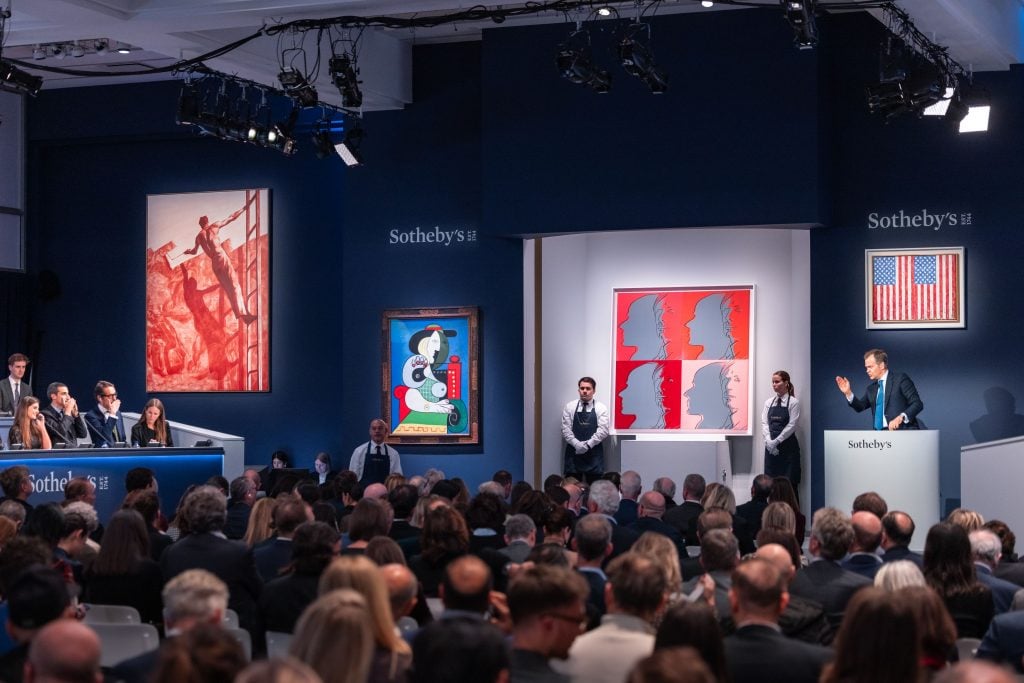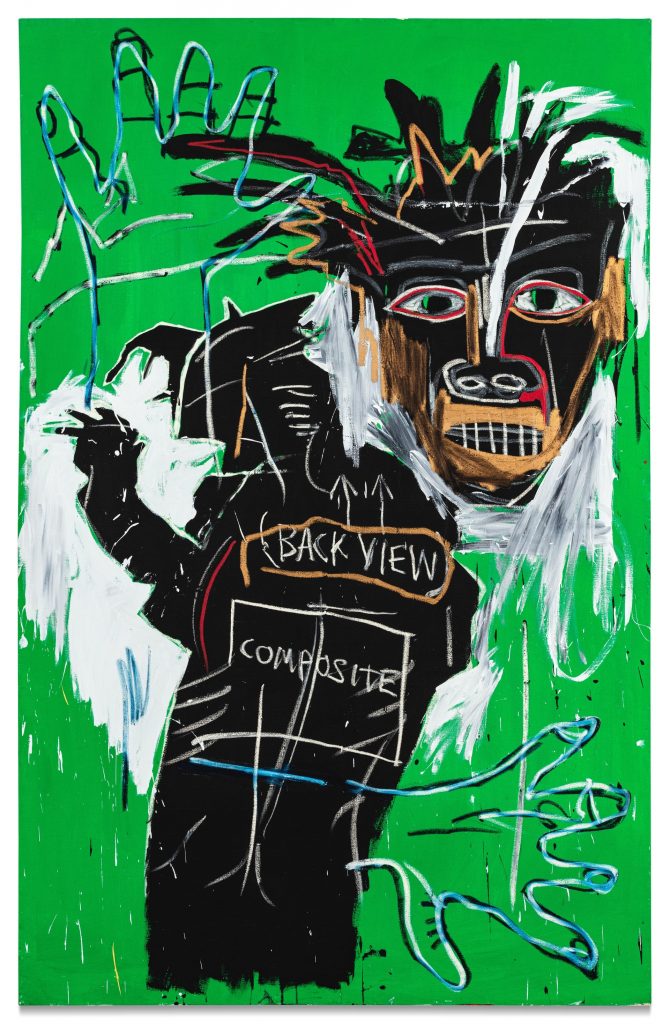The Back Room
The Back Room: Quandary Vs. Crisis
Auction-week anxieties, collector conservatism, a Basquiat that may soon rank among the most expensive self-portraits ever, and more.

Auction-week anxieties, collector conservatism, a Basquiat that may soon rank among the most expensive self-portraits ever, and more.

Artnet News

Every Friday, Artnet News Pro members get exclusive access to the Back Room, our lively recap funneling only the week’s must-know intel into a nimble read you’ll actually enjoy.
Editor’s Note: Today we’re welcoming Margaret Carrigan to the Back Room as guest contributor. Margaret has been covering the art market and its wily ways for the better part of a decade (which she was shocked to realize when attempting to calculate this figure, since it seems like yesterday). Formerly a senior editor at The Art Newspaper, she has also been a regular contributor to outlets such as Galerie, Cultured, and Observer, among others. Weirdly, she has also been working at a tech start-up for the last three years, just to see what it was like.
This week in the Back Room: auction-week anxieties, collector conservatism, a Basquiat that may soon rank among the most expensive self-portraits ever, and much more—all in a 6.5-minute read (1,856 words).

The room at Sotheby’s evening auction of the collection of Emily Fisher Landau. Courtesy of Sotheby’s.
This November has been a nervous one as the art world has awaited the start of New York’s powerhouse fall sales cycle, after the cautious buying seen in London’s patchy October auctions and Manhattan’s middling May sales earlier this year. The annual Survey of Global Collecting didn’t do much to temper the art world’s agita.
Authored by economist Clare McAndrew and published just ahead of this week’s sales by Art Basel and UBS, the report’s up-and-down findings, when considered together, sketch a recognizable portrait of the soft and slippery market seen this year amid inflationary economic pressures and war in Ukraine and Gaza. The report suggests some growth since 2022 and into the first half of 2023: imports of art and antiques across borders reached their highest-ever level of $30.7 billion in 2022, and exports reached their second highest at $33.4 billion. Additionally, spending remained strong, especially among Mainland China-based collectors—although this could be changing in light of the region’s economic slowdown this fall. Auction sales, however, were down by 16 percent in the first six months of 2023 over the same period a year earlier.
Yet the share of collectors focused on buying works of art priced at over $1 million rose to 9%, according to the report. While that’s a welcome uptick from 2022’s 4% it’s anemic compared to the >12% of 2021 and before. Additionally, the average allocation to art in the wealth portfolios of high net worth individuals fell to 19% in 2023, from 24% in 2022. Lastly, spending on both digital art (unsurprisingly) and works by women artists (regrettably) also fell to 2020 levels.
Given the peri-pandemic spending frenzy of 2021 and the crypto winter of 2022, these fluctuating figures aren’t surprising, especially amid 2023’s inflation. That’s plain to see in more speculative markets, like art-related NFTs, which have gone by the wayside, evident in the fall to 3% of total spending on digital art.
It’s more nuanced when it comes to work by women artists, prices for which have been on the rise but still well behind those for male peers. While collectors spent less overall on works by women in 2022 and 2023, those spending over $10 million a year tended to have both a higher share of female artists’ works in their collections (54%) and their proportion of spending also increased to 55% in 2023, from 46% in 2021. This suggests that some of the spending at the very highest levels was on work by women, according to the Art Basel and UBS report.
If anything, the numbers suggest that plenty of money is still out there, it just costs more to spend it currently and collectors may be looking for sure bets and better deals. This has certainly borne out in the sales so far this week. Sotheby’s white-glove (and fully guaranteed) Emily Fisher Landau sale on Thursday night became the most valuable auction dedicated to a female collector in history, as Artnet’s own Annie Armstrong reported. The evening brought in $406.4 million (all prices including fees), in line with its pre-sale estimate of $344.5 million to $430.1 million. The headlining lot of the sale—and the season—was Picasso’s Femme à la montre (1932), which hammered at just over its $120 million estimate and sold for a total of $139.4 million after taxes and fees. It’s the highest price of any work to come to auction all year.
In keeping with the conjecture that higher sums are being paid for work by women (even if the overall spending in this sector is down), Agnes Martin’s Grey Stone II impressed at the Landau sale, selling for $18.7 million—three times its low estimate of $6 million and a new auction record for the minimalist artist. Meanwhile, works by Robert Rauschenberg, Mark Rothko, and Jean Dubuffet went for their low estimates or less.
Christie’s $107.5 million 21st-century evening sale on Tuesday didn’t have the same single-owner caché to buoy it this season but works by newer names—all women or Black artists—sailed past their estimates, while lots by several blue-chip artists that normally trade well barely hit theirs. Among the uber-contemporary highlights was Jia Aili’s triptych Combustion (2016), which sold for $4.8 million. And, despite the fact that a couple of Jadé Fadojutimi’s works fared poorly in London’s October sales, the artist’s A Thistle Throb (2021) fetched $1.68 million. Both Aili’s and Fadojutimi’s works sold for roughly twice their estimates and set records for the artists.
If the adage that collectors seek security in blue-chip works in times of crisis still holds true, then the market is in more of a quandary than a crisis. There is still an appetite for work by young and/or underrepresented artists, and while sales results may reflect collectors’ nascent conservative side, not all prices are going down.
The latest Wet Paint was still being mixed at press time, but here’s what else made a mark around the industry since last Friday morning…
Art Fairs
– The third edition of Japan’s Art Collaboration Kyoto (ACK) saw solid sales and even stronger exhibitor reviews thanks to its unique model that requires collaboration between international and Japanese galleries. (Artnet News)
– India Art Fair returns to the NSIC Exhibition Grounds in New Delhi for its 15th edition, running February 1-4, 2024. Featuring 100 exhibitors, among them 18 international galleries and 10 first-time South Asian institutional participants, the fair will also launch a new Design section that highlights contemporary takes on traditional craftsmanship. (Press Release)
Auction Houses
– At Sotheby’s, a white-glove Emily Fisher Landau evening sale continued the trend of successful single-owner sales this year, netting out at $406.4 million and marking the most valuable auction dedicated to a female collector in history. Roughly a third of the sale total was due to the sale of Picasso’s Femme à la montre (1932) for $139.4 million, making it the second-most expensive piece by Picasso to sell at auction. (Artnet News)
– Newer works won out at Christie’s 21st century evening sale, while blue-chip lots underperformed, opening New York’s autumn auction on an uneasy note. (The Art Newspaper)
– Here’s a breakdown of the results of the Fisher Landau sale. (Artnet News)
Galleries
– Kenyan Painter Kaloki Nyamai joins James Cohan’s roster and Zhao Gang signs with Lisson Gallery. (Press releases)
– Sharis Alexandrian departs Lévy Gorvy Dayan to join Gagosian as international director, based in London. Alexandrian became a senior director at Lévy Gorvy in 2019 after a seven-year stint at White Cube. (Press release)
– JDJ is the most recent gallery to open up a space in the ever-buzzing neighborhood of Tribeca at 370 Broadway. (Wet Paint)
Institutions & Biennials
– The head of Hungary’s National Museum was fired for allegedly letting minors view LGBTQ content featured in the recent World Press Photo exhibition. A controversial Hungarian law bans the “display and promotion of homosexuality” in materials accessible to children. The dismissed director, Laszlo Simon, says the museum complied with the government’s order to restrict exhibition entry for under-18s. (BBC)
– The Louvre is fundraising €1.3 million to acquire Jean Siméon Chardin’s Basket of Wild Strawberries (1761). The work sold for €24 million to the Kimbell Art Museum in Fort Worth, Texas, last year, but the Louvre blocked the export of the work after the sale. LVMH has donated €16 million to the Louvre in support of the acquisition. (The Art Newspaper)
– Workers at the Brooklyn Museum have ratified their first union contract, guaranteeing them pay increases and avoiding a strike. (Artnet News)
– Anne-Marie Russell, the executive director and chief executive of the Museum of Fine Arts in St. Petersburg will step down from her post on March 1, 2024. (ARTnews)
– Nadia Abdelkaui will join the Stedelijk Museum in Amsterdam as curator of modern art, starting January 15, 2024. (Press Release)
Tech and Legal News
– The British Museum has released new details around the theft of 2,000 Greek and Roman antiquities. An independent review determined the thievery started as early as 1993; no suspect has been formally named but a former curator, Peter Higgs, has been identified as a person of interest in the case. (ARTnews)
– A U.S. federal judge has ruled in favor of William Nile Elam III’s ownership claim over Norman Rockwell works that once hung in the White House. At the time of their completion, the original artworks were given to Franklin D. Roosevelt’s press secretary Stephen T. Early, whose heirs are behind the bitter inheritance legal battle that began in 2017. (Artnet News)
“Twenty years ago, people thought you had to be the member of an elite club to walk through an auction house door… now you can see a sale sitting on your couch in your underpants.”
—Adrien Meyer, Christie’s global head of private sales and one of the company’s chief auctioneers, on the post-Covid popularity of video-streamed auctions, which now have the live production team behind them of a mid-sized news network. (New York Times)

Jean Michel Basquiat, Self-Portrait as a Heel (Part Two) (1982). Courtesy of Sotheby’s.
Date: 1982
Estimate: $40–60 million
Selling at: Sotheby’s New York
Sale date: November 15, 2023
It’s a Back Room Basquiat back-to-back—or Basq-to-Basq, if you will. We’ve got our eye on the artist’s Self-Portrait as a Heel (Part Two), the star lot of Sotheby’s contemporary evening auction in New York. One of only three works Basquiat made while in L.A. that incorporates the “heel” slogan—a slang word favored by the artist and used to denote a criminal or, in pro-wrestling, an anti-hero—the painting has passed through several hands since its creation in 1982. Among them is collector and dealer Stéphane Janssen, an early supporter of Basquiat, who bought the work from Larry Gagosian in 1985 before consigning it to Christie’s in 1999, where it sold for $772,500. It now bears an estimate of $40-$60 million—a nearly 200% appreciation in value since its last appearance on the secondary market.
According to the auction house, it’s one of the most significant works by Basquiat to appear at auction and, should it fetch in the realm of its estimate, one of the most expensive self-portraits of any era. Basquiat also holds the record for the highest price ever paid at auction for a work by an American artist in a public sale, for his painting Untitled (1982), which sold in May 2017 for $110.5 million, also at Sotheby’s.
—Margaret Carrigan